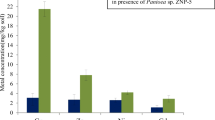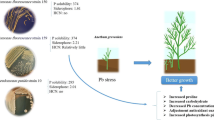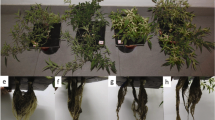Abstract
For effective microbe-assisted bioremediation, metal-resistant plant growth-promoting bacteria (PGPB) must facilitate plant growth by restricting excess metal uptake in plants, leading to prevent its bio-amplification in the ecosystem. The aims of our study were to isolate and characterize copper (Cu)-resistant PGPB from waste water receiving contaminated soil. In addition, we investigated the phytotoxic effect of copper on the lentil plants inoculated with copper-resistant bacteria Providencia vermicola, grown in copper-contaminated soil. Copper-resistant P. vermicola showed multiple plant growth promoting characteristics, when used as a seed inoculant. It protected the lentil plants from copper toxicity with a considerable increase in root and shoot length, plant dry weight and leaf area. A notable increase in different gas exchange characteristics such as A, E, C i , g s , and A/E, as well as increase in N and P accumulation were also recorded in inoculated plants as compared to un-inoculated copper stressed plants. In addition, leaf chlorophyll content, root nodulation, number of pods, 1,000 seed weight were also higher in inoculated plants as compared with non-inoculated ones. Anti-oxidative defense mechanism improved significantly via elevated expression of reactive oxygen species -scavenging enzymes including ascorbate peroxidase, superoxide dismutase, catalase, and guaiacol peroxidase with alternate decrease in malondialdehyde and H2O2 contents, reduced electrolyte leakage, proline, and total phenolic contents suggesting that inoculation of P. vermicola triggered heavy metals stress-related defense pathways under copper stress. Overall, the results demonstrated that the P. vermicola seed inoculation confer heavy metal stress tolerance in lentil plant which can be used as a potent biotechnological tool to cope with the problems of copper pollution in crop plants for better yield.





Similar content being viewed by others
Abbreviations
- PGPB:
-
plant growth promoting bacteria
- Cu:
-
copper
- PGP:
-
plant growth promoting
- A :
-
net photosynthetic rate
- E :
-
transpiration rate
- C i :
-
internal CO2 concentration
- g s :
-
stomatal conductance
- A/E :
-
water use efficiency
- SOD:
-
superoxide dismutase
- CAT:
-
catalase
- GPX:
-
guaiacol peroxidase
- MIC:
-
minimum inhibitory concentration
- MDA:
-
malondialdehyde
- H2O2 :
-
hydrogen peroxide
- TPC:
-
total phenolic contents
- N:
-
nitrogen
- P:
-
phosphorous
- P. vermicola :
-
Providencia vermicola
References
Aebi H (1974) Catalases. Methods Enzym Anal 2:673–684
Akhtar S, Ali B (2011) Evaluation of rhizobacteria as non-rhizobial inoculants for mung beans. Aust J Crop Sci 5:1723–1729
Alexander DB, Zuberer DA (1991) Use of chrome azurol S reagents to evaluate siderophore production by rhizosphere bacteria. Biol Fert Soils 12:39–45
Allen E, Grimshaw H, Parkinson J, Quamby C, Roberts J (1986) Chemical analysis. Methods plant ecology. Blackwell Scientific, London, pp 285–344
Arnon DI (1949) Copper enzymes in isolated chloroplasts. Polyphenoloxidase in Beta vulgaris. Plant Physiol 24:1–15
Arora N, Kang S, Maheshwari D (2001) Isolation of siderophore producing strains of Rhizobium meliloti and their bio-control potential against Macrophomina phaseolina that causes charcoal rot of groundnut. Curr Sci 81:673–677
Bates L, Waldren R, Teare I (1973) Rapid determination of free proline for water-stress studies. Plant Soil 39:205–207
Belimov A, Safronova V, Demchinskaya S, Piluzza G, Bullitta S (2005) Cadmium-tolerant plant growth-promoting rhizobacteria associated with the roots of Indian mustard (Brassica juncea L. Czern.). Soil Biol Biochem 37:241–250
Bergey DH, Holt JG, Krieg NR, Sneath PHA (1994) Bergey's Manual of Determinative Bacteriology, 9th ed., (Breed RS, Murray EGD and Smith NR, eds.) Williams and Wilkims, Baltimore
Bradford MM (1976) A rapid and sensitive method for the quantitation of microgram quantities of protein utilizing the principle of protein-dye binding. Analy biochem 72: 248--254
Bremner J, Mulvaney C (1982) Nitrogen-total. Methods of soil analysis. Part 2. Chemical and Microbiological Properties 595–624
Bruins M, Kapil S, Oehme F (2000) Microbial resistance to metals in the environment. Ecot Environ Saf 45:198–207
Cambroll J, Mateos-Naranjo E, Redondo-Gomez S, Luque-Palomo M, Figueroa M (2011) Growth, reproductive and photosynthetic responses to copper in the yellow-horned poppy, Glaucium flavum Crantz. Environ Exp Bot 71:57–64
Cohu CM, Pilon M (2007) Regulation of superoxide dismutase expression by copper availability. Physiol Plant 129:747–755
Demiral T, Türkan İ (2005) Comparative lipid peroxidation, antioxidant defense systems and proline content in roots of two rice cultivars differing in salt tolerance. Environ Exp Bot 53:247–257
Demirevska-Kepova K, Simova-Stoilova L, Stoyanova Z, Hölzer R, Feller U (2004) Biochemical changes in barley plant safter excessive supply of copper and manganese. Environ Exp Bot 52:253–266
Dhindsa SR, Matowe W (1981) Drought tolerance in two mosses: correlated with enzymatic defence against lipid peroxidation. J Exp Bot 32:79–91
Duganath N, Reddy KN, Nagasowjanya J, Sridhar S, Jayaveera KN (2010) Evaluation of phytochemical and in vitro antioxidant activity of Filicium decipiens. Ann Biol Res 1:134–140
Duponnois R, Kisa M, Assigbetse K, Prin Y, Thioulouse J, Issartel M, Moulin P, Lepage M (2006) Fluorescent pseudomonads occurring in Macrotermes subhyalinus mound structures decrease Cd toxicity and improve its accumulation in sorghum plants. Sci Total Environ 370:391–400
Fiske C, Subbarow Y (1925) The colorimetric determination of phosphorus. J Biol Chem 66:375–400
Gamalero E, Berta G, Massa N, Glick BR, Lingua G (2008) Synergistic interactions between the ACC deaminase-producing bacterium Pseudomonas putida UW4 and the AM fungus Gigaspora rosea positively affect cucumber plant growth. FEMS Microbiol Ecol 64:459–467
Gao S, Yan R, Cao M, Yang W, Wang S, Chen F (2008) Effects of copper on growth, antioxidant enzymes and phenylalanine ammonia-lyase activities in Jatropha curcas L. seedling. Plant Soil Environ 54(3):117–122
Gibbons S, Feris K, McGuirl M, Morales S, Hynninen A, Ramsey P, Gannon J (2011) Use of microcalorimetry to determine the costs and benefits to Pseudomonas putida strain KT2440 of harboring cadmium efflux genes. Appl Environ Microbiol 77(1):108–113
Gill S, Tuteja N (2010) Reactive oxygen species and antioxidant machinery in abiotic stress tolerance in crop plants. Plant Physiol Biochem 48:909–930
Glick BR (2005) Modulation of plant ethylene levels by the bacterial enzyme ACC deaminase. FEMS Microbiol Lett 251:1–7
Glickman E, Dessaux Y (1995) A critical examination of the specificity of the Salkowski reagent for indolic compounds produced by phytopathogenic bacteria. Appl Environ Microbiol 61:793–796
González-Mendoza D, Espadas y Gil F, Escoboza-Garcia F, Santamaría JM, Zapata-Perez O (2013) Copper stress on photosynthesis of black mangle (Avicennia germinans). An Acad Bras Cienc 85(2):665–670
Gratão PL, Polle A, Lea PJ, Azevedo RA (2005) Making the life of heavy metal-stressed plants a little easier. Func Plant Biol 32:481–494
Gururani M, Upadhyaya C, Baskar V, Venkatesh J, Nookaraju A, Park S (2012) Plant growth-promoting rhizobacteria enhance abiotic stress tolerance in solanum tuberosum through inducing changes in the expression of ros-scavenging enzymes and improved photosynthetic performance. J Plant Growth Regul 32:245–258
Gururani M, Upadhyaya C, Baskar V, Venkatesh J, Nookaraju A, Park S (2013) Plant growth-promoting rhizobacteria enhance abiotic stress tolerance in solanum tuberosum through inducing changes in the expression of ros-scavenging enzymes and improved photosynthetic performance. J Plant Growth Regul 32(2):245–258
Halliwell B, Gutteridge J (1984) Oxygen toxicity, oxygen radical, transition metals and disease. Biochem Int J 219:1–14
Harley (2014) Laboratory resource guide laboratory exercises in microbiology. 9th edition. McGraw-Hill Education
Huaidong H, Zhihong Y, Danjing Y, Junlan Y, Xiao L, Zhong T, Yuan M, Cai X, Fang Z, Jing Y (2012) Characterization of endophytic Rahnella sp. JN6 from Polygonum pubescens and its potential in promoting growth and Cd, Pb, Zn uptake by Brassica napus. Chemosphere 90:1960–1965
Islam F, Yasmeen T, Ali Q, Ali S, Arif MS, Hussain S, Rizvi H (2014a) Influence of Pseudomonas aeruginosa as PGPR on oxidative stress tolerance in wheat under Zn stress. Ecotox Environ Safe 104:285–293
Islam F, Yasmeen T, Riaz M, Arif MS, Ali S, Raza SH (2014b) Proteus mirabilis alleviates zinc toxicity by preventing oxidative stress in maize (Zea mays) plants. Ecotox Environ Safe 110:143–152
Jakson M (1967) Soil chemical analysis. Prentice Hall of India Ltd, New Delhi
Jalili F, Khavazi K, Pazira E, Nejati A, Rahmani H, Sadaghiani H, Miransari M (2009) Isolation and characterization of ACC deaminase-producing fluorescent pseudomonads, to alleviate salinity stress on canola (Brassica napus L.) growth. J Plant Physiol 166:667–674
Janas K, Ska-Tomaszewska J, Rybaczek D, Maszewski J, Posmyk M, Amarowicz R, Kosińska A (2010) The impact of copper ions on growth, lipid peroxidation and phenolic compound accumulation and localization in lentil (Lens culinaris Medic.) seedlings. J Plant Physiol 167:270–276
Kafel A, Nadgórska-Socha A, Gospodarek J, Babczyńska A, Skowronek M, Kandziora M, Rozpędek K (2010) The effects of Aphis fabae infestation on the antioxidant response and heavy metal content in field grown Philadelphus coronarius plants. Sci Total Environ 408:1111–1119
Kardas M, Gozen AG, Severcan F (2014) FTIR spectroscopy offers hints towards widespread molecular changes in cobalt-acclimated freshwater bacteria. Aquat Toxicol 155:15–23
Ke W, Xiong Z, Xie M, Luo Q (2007) Accumulation, subcellular localization and ecophysiological responses to copper stress in two Daucus carota L. populations. Plant Soil 292:291–304
Khan N, Tuffin M, Stafford W, Cary C, Lacap DC, Pointing SB, Cowan D (2011) Hypolithicmicrobial communities of quartz rocks from Miers Valley, McMurdo Dry Valleys, Antarctica. Polar Biol 34:1657–1668
Kovacik J, Backor M (2008) Phenolic compounds composition and physiological attributes of Matricaria chamomilla grown in copper excess. Environ Exp Bot 62:145–152
Kumar P, Dushenkov V, Motto H, Raskin I (1995) Phytoextraction: The use of plants to remove heavy metals. Environ Sci Technol 29:1232–1238
Lamb DT, Ming H, Megharaj M, Naidu R (2009) Heavy metal (Cu, Zn, Cd, and Pb) partitioning and bioaccessibility in uncontaminated and long-term contaminated soils. J Harzad Mater 171:1150–1158
Li J, McConkey BJ, Cheng Z, Guo S, Glick BR (2013) Identification of plant growth-promoting bacteria-responsive proteins in cucumber roots under hypoxic stress using a proteomic approach. J Proteom 84:119–131
Lima A, Corticeiro S, Figueira E (2006) Glutathione-mediated cadmium sequestration in Rhizobium leguminosarum. Enzy Microb Technol 39:763–769
Lin J, Jiang W, Liu D (2003) Accumulation of copper by roots, hypocotyls, cotyledons and leaves of sunflower (Helianthus annuus L.). Biores Technol 86:151–159
Liu T, Shen C, Wang Y, Huang C, Shi J (2014) New insights into regulation of proteome and polysaccharide in cell wall of Elsholtzia splendens in response to copper stress. Plos One 9(10):1–13
Ma Y, Prasad M, Rajkumar M, Freitas H (2011) Plant growth promoting rhizobacteria and endophytes accelerate phytoremediation of metalliferous soils. Biotechnol Adv 29:248–258
Ma Y, Rajkumar M, Luo Y, Freitas H (2013) Phytoextraction of heavy metal polluted soils using Sedum plumbizincicola inoculated with metal mobilizing Phyllobacterium myrsinacearum RC6b. Chemosphere, 93(7): 1386--1392
Martínez-Alcalá I, Clemente R, Bernal M (2009) Metal availability and chemical properties in the rhizosphere of Lupinus albus L. growing in a high-metal calcareous soil. Water Air Soil Poll 201:283–293
Mayak S, Tirosh T, Glick BR (2004) Plant growth-promoting bacteria confer resistance in tomato plants to salt stress. Plant Physiol Biochem 42:565–572
McLellan T, Marr ES, Wondrack LM, Subashi TA, Aeed PA, Han S, Xu Z, Wang IK, Maguire BA (2009) A systematic study of 50S ribosomal subunit purification enabling robust crystallization. Acta Crystallo 65:1270–1282
Mishra S, Srivastava S, Tripathi R, Govindarajan R, Kuriakose S, Arasad M (2006) Phytochelatin synthesis and response of antioxidants during cadmium stress in Bacopa monnieri L. Plant Physiol Biochem 44:25–37
Møller I, Jensen P, Hansson A (2007) Oxidative modifications to cellular components in plants. Annu Rev Plant Biol 58:459–481
Nakano Y, Asada K (1981) Hydrogen peroxide is scavenged by ascorbate specific peroxidase in spinach chloroplasts. Plant Cell Physiol 22:867–880
Nautiyal C, Srivastava S, Chauhan P (2008) Rhizosphere colonization: molecular determinants from plant-microbe coexistence perspective. In: Nautiyal CS, Dion P (eds) Molecular mechanisms of plant, microbe coexistence, soil biology series. Springer, Berlin, pp 99–124
Nies D (2003) Efflux-mediated heavy metal resistance in prokaryotes. FEMS Microbiol Rev 27:313–339
Opdenakker K, Remans T, Keunen E, Vangronsveld J, Cuypers A (2012) Exposure of Arabidopsis thaliana to Cd or Cu excess leads to oxidative stress mediated alterations in MAPKinase transcript levels. Environ Exp Bot 83:53–61
Oves M, Khan M, Zaidi A (2013) Chromium reducing and plant growth promoting novel strain Pseudomonas aeruginosa OSG41 enhance chickpea growth in chromium amended soils. Eur J Soil Biol 56:72–83
Peng H, Yang X, Yang M, Tian S (2006) Responses of antioxidant enzyme system to copper toxicity and copper detoxification in the leaves of Elsholtzia splendens. J Plant Nutr 29:1619–1635
Penrose DM, Glick BR (2003) Methods for isolating and characterizing ACC deaminase-containing plant growth-promoting rhizobacteria. Physiol Plant 118:10–15
Pinto AP, Alves AS, Candeias AJ, Cardoso AI, de Varennes A, Martins LL, Mourato MP, Gonçalves ML, Mota AM (2009) Cadmium accumulation and antioxidative defences in Brassica juncea L. Czern, Nicotiana tobacum L. and Solanum nigrum L. Int J Environ 89:661–676
Rajkumar M, Prasad M, Freitas H, Ae N (2009) Biotechnological applications of serpentine soil bacteria for phytoremediation of trace metals. Crit Rev Biotechnol 29:120–130
Rajkumar M, Prasad M, Sandhya S, Freitas H (2013) Climate change driven plant-metal-microbe interactions. Environ Int 53:74–86
Rao L, Perez D, White E (1996) Lamin proteolysis facilitates nuclear events during apoptosis. J Cell Biol 135:1441–1455
Rascio N, Navari-Izzo F (2011) Heavy metal hyper accumulating plants: how and why do they do it? And what makes them so interesting? Plant Sci 180:169–181
Shanker AK, Cervantes C, Loza-Tavera H, Avudainayagam S (2005) Chromium toxicity in plants. Environ Int 31:739–753
Siripornadulsil S, Siripornadulsil W (2013) Cadmium-tolerant bacteria reduce the uptake of cadmium in rice: potential for microbial bioremediation. Ecotoxicol Environ Safe 94:94–103
Sudisha J, Niranjana SR, Umesha S, Prakash HS, Shetty HS (2006) Transmission of seed-borne infection of muskmelon by Didymella bryoniae and effect of seed treatments on disease incidence and fruit yield. Biol Cont 37:196–205
Tak HI, Ahmad, Babalola OO (2013) Advances in the Application of plant growth-promoting rhizobacteria in phytoremediation of heavy metals. Rev Environ Contamin Toxicol In Whitacre, D M (Ed). IX, 147 p. 21 illus., 3 illus. Vol. 223
Velikova V, Yordanov I, Edreva A (2000) Oxidative stress and some antioxidant systems in acid rain-treated bean plants: protective role of exogenous polyamines. Plant Sci 151:59–66
Vivas A, Biro B, Ruiz-Lozano J, Barea J, Azcon R (2006) Two bacterial strains isolated from a Zn-polluted soil enhance plant growth and mycorrhizal efficiency under Zn-toxicity. Chemosphere 62:1523–1533
Wang H, Xu R, You L, Zhong G (2013) Characterization of Cu-tolerant bacteria and definition of their role in promotion of growth, Cu accumulation and reduction of Cu toxicity in Triticum aestivum L. Ecotoxicol Environ safety 94: 1--7
Wang L, Yang X, Ren Z, Hu X, Wang X (2014) Alleviation of photosynthetic inhibition in copper-stressed tomatoes through rebalance of ion content by exogenous nitric oxide. Turk J Bot 38:1312–1317
Wani P, Khan M, Zaidi A (2008) Effect of metal-tolerant plant growth-promoting Rhizobium on the performance of pea grown in metal-amended soil. Arch Environ Contam Toxicol Appl Pharmacol 55:33–42
Yang J, Kloepper J, Ryu C (2009) Rhizosphere bacteria help plants tolerate abiotic stress. Trends Plant Sci 14:1–4
Yilmaz EI (2003) Metal tolerance and biosorption capacity of Bacillus circulans strain EB1. Res Microbiol 154:409–415
Zaidi S, Usmani S, Singh B, Musarrat J (2006) Significance of Bacillus subtilis strain SJ-101 as a bio-inoculant for concurrent plant growth promotion and nickel accumulation in Brassica juncea. Chemosphere 64:991–997
Zhang LL, He XJ, Chen M, An RD, An XL, Li J (2014) Responses of nitrogen metabolism to copper stress in Luffa cylindrica roots. J Soil Sci Plant Nutr 14(3):616–624
Acknowledgments
The authors thank the Higher Education Commission of Pakistan for the financial support under project No: PM-IPFP/HRD/HEC/2011/0582.
Author information
Authors and Affiliations
Corresponding author
Additional information
Responsible editor: Hailong Wang
Rights and permissions
About this article
Cite this article
Islam, F., Yasmeen, T., Ali, Q. et al. Copper-resistant bacteria reduces oxidative stress and uptake of copper in lentil plants: potential for bacterial bioremediation. Environ Sci Pollut Res 23, 220–233 (2016). https://doi.org/10.1007/s11356-015-5354-1
Received:
Accepted:
Published:
Issue Date:
DOI: https://doi.org/10.1007/s11356-015-5354-1




